It was only in the morning that I realised I was actually in the VIP area. I had no idea. The VIP area was separated by a wire at neck height, with VIP paper signs stuck along it, so if anyone dared to break in they would get cloth-lined at the wire.
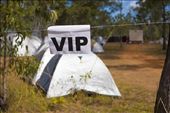
The accommodation set up was huge. Here we were in the middle of nowhere, living in an enormous tent city of more than 2000 tents. There were tents as far as the eye could see, which brought home the huge scale of this event, and the work that was involved in setting it all up in the weeks leading up to the festival. I spoke to one guy, Tim, who set up most of the tents himself. He said he does a tent in 3 minutes. I was amazed. I can’t compete with that. It takes me 15 mins to set up one!
Breakfast was from anywhere between 6:30 to 9am. Because I hadn't slept well the night before I was unusually early eating my 3 (small plastic travel) bowls of nutre-grain, 2 tubs of yoghurt and some really watery cordial at 7am! It was good to be there then because I wanted to be ready for the day ahead and not accidentally sleep through the lot.
After breakfast I got all my gear together and went to the reception area where we caught a bus to Yirrkala, the small town near by where we visited the Yolngu School and later to the Buku-Larrngay Mulka Art Centre.
Visiting the school was an amazing experience. It’s a school only for Yolngu children, teaching them maths and geography with traditional dance and cultural learning programs in place to nurture the culture of their people, educating them in their law, whilst teaching them important things like learning to read and write in their language and in English.
The children had set up stalls were they were selling items to raise money for the school. One stall, managed by a small group of young girls were selling jewellery which they had made from a mix of fluro-coloured beads and sea shells. They were very cute about it, using a toy plastic cash register, politely serving customers, taking it all very seriously. They did a great job. Their work was hanging from a branch painted white with items hanging off it. Other stalls were selling iced juice, and various other things.
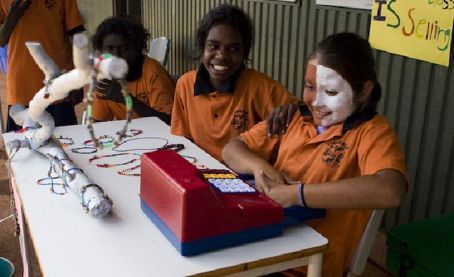
We waited on the open grass area for the children’s bungul (dancing) presentation that was being organised by the teachers out the back. It took a while to organise the sea of colourfully painted children, but I didn’t mind the wait, as I knew it was worth waiting for. Eventually the children emerged, with the girls to the left and the boys on the right. I walked up to the front to get a few shots of them coming out from behind the building. They were all very shy, as most Yolngu people are, and I can imagine how daunting it was for them to perform to a few hundred faces all watching them. The children really didn’t need to do much because they looked absolutely beautiful. Their smiling painted faces and wonderful bright coloured costumes were entrancing enough to please the audience and I couldn’t wipe the smile of my face, from the sheer joy it was to be there on that bit of grass to witness the future generation of the Yolngu people embracing their bungul, and doing such a great job of it. The children followed the lead of the teachers who were also painted up and colourfully dressed. It was an awesome experience.
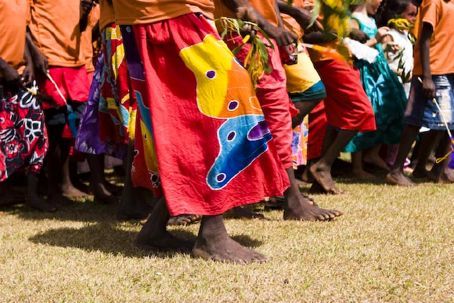
I had a young boy sitting on my lap for most of it. He was fascinated by my camera and wanted to look through it all the time. I didn’t mind, I thought he was pretty funny, not shy at all. I let him look through the camera when I got tired of taking photos. He took a few and some actually turned out ok. He loved it. I took his photo (see below). It was very hard getting him to stand still.
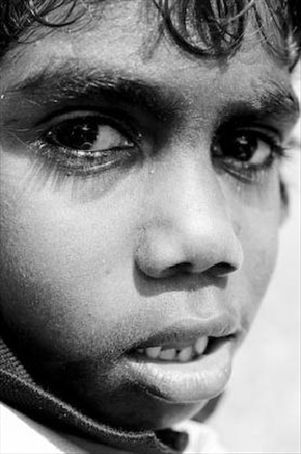
After visiting the school two beautiful young girls and I walked to the gallery for the opening, because we had missed the bus that drove the others there. But I didn’t mind, perfect company, perfect weather, (27 degrees with a nice sea breeze), how could I complain?
The Yolngu people are internationally renowned for their cross-hatching painting technique, which is unique to their people. The Buku-Larrngay Mulka Art Centre has a collection of work in this style and other styles from past and present Yolngu artists. Most of the work is painted on bark (which is their traditional canvas) a technique they still use today, with other works painted on hollowed tree logs and sea shells. The work that is part of the collection is not for sale, but they also have an awesome shop where you can buy art works and other items such as grass bags. It doesn’t take long to realise why their style of work is so famous worldwide. They put their heart and soul into it, with each delicate brush stroke contributing to a powerful work of art.
The occasion for being there was for the opening of the extension to the gallery. Many people gave speeches and as I was sitting directly in the sun, my patience was wearing thin, and by this stage I was very tired. Other photographers were getting photos of the people talking and I was thinking to myself, maybe I should be out there taking a few, even though speech photos aren’t really my thing. But to my good fortune I was actually in the best spot. Dr. Gawirrin Gumana AO, a chief elder and artist was given the honour of officially opening the extension in “honour of the 48 Artists of Saltwater-Yirrkala Bark Paintings of Sea Country,” as written on the plaque on the large white stone commemorating the occasion. I was sitting right next to the stone where they were about to have the opening ceremony. The Dr. and other elders were singing and one was clapping sticks together as the cloth was pulled off, and the bright white stone was revealed. It was very exciting, I just happened to be in the perfect spot. Other media people rushed to where I already was, but by then it was too late.
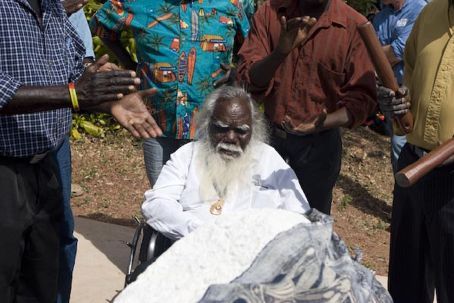
Dr. Gawirrin Gumana AO (above)
That evening was my first taste of the bungul (dancing). The Bungul is the centre-point to the whole festival. The Yolngu clan groups have been coming to this spot, a large square area of sand, for hundreds of years. It’s only in the last 9 years that they’ve made a festival out of it. So really Garma is for the Yolngu people, and visitors have been invited to help preserve and nurture their culture and traditions through cultural tourism.
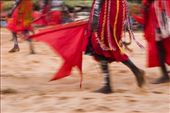
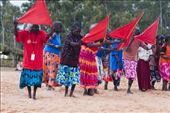
Every Yolngu clan group have their own unique names, songs, dances, and designs, which have been passed down to them from their ancestors, giving them their law, traditions and the yidaki (didgeridu). Watching the dancing is a truly awesome experience. The vibrancy in the colours they wear, and the energy expressed blew me away. They clearly show the depth of their ability and fitness in dancing from 4pm til sunset and sometimes later, and they’re still beaming and overflowing with positive energy by the end.
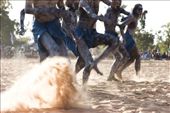

Most dances involve the throwing up of sand into the air by the thrusting and moving of the feet through the sand, which was awe-inspiring to watch.
Sand is difficult enough to walk in let alone dance in for hours! It also amazes me that each clan group has such a unique style, and yet each is so skilful, so empowering, and so beautiful. As the daylight fades over the horizon, the light produces beautiful soft colour casts enriching the colourful display of the bungul.
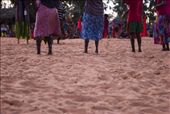
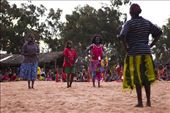
That night I went to the opening of the Gapan Gallery. Little red candles lit the pathway to the gallery, as everything was pitch black. The candlelight was beautiful, casting a faint red glow through the gallery. We gathered around the site, unaware of what was about to happen. I could faintly see a group of Yolngu women (who I later found out were the artists of the work) were sitting in the middle of the gallery.
Gapan Gallery is the most amazing gallery in the world, it’s an open air gallery nestles amongst a dense forest of gum trees, with a sand floor marking out the Gallery space with all the trees in this area painted white. I had no idea what to expect. I have never actually been to an open-air gallery like this. Then in the dark a Yolngu woman started explaining their beliefs of the land, and said they were going to call out to the land and ask for forgiveness… a short pause followed… then the women started wailing. They were so distraught. They were over come by emotion. I could feel the deep effect it was having on the people around me, I too felt moved. The women continued to cry, asking for forgiveness from the land. There was a silence… then boom. White light flooded the sky, burning the back of my eyeballs. What a shock! A beautiful shock! For a second there I thought it was the end of the world. The lights had been switched on and suddenly we could see the artworks hanging on the trees, and the sheer beauty and majesty of the gallery space was revealed. It was such a powerful experience. I so wasn’t expecting the lights to go on, and to be so powerful. Definitely a life experience.
The artworks were absolutely beautiful. If I had money I would have bought a few. Some of it was quite contemporary, with a few flavours from the past. But I was really blown away by the modern, quite abstract work, like that of nothing I have ever seen before, modern yet still with traditional aspects passed down from their ancestors.